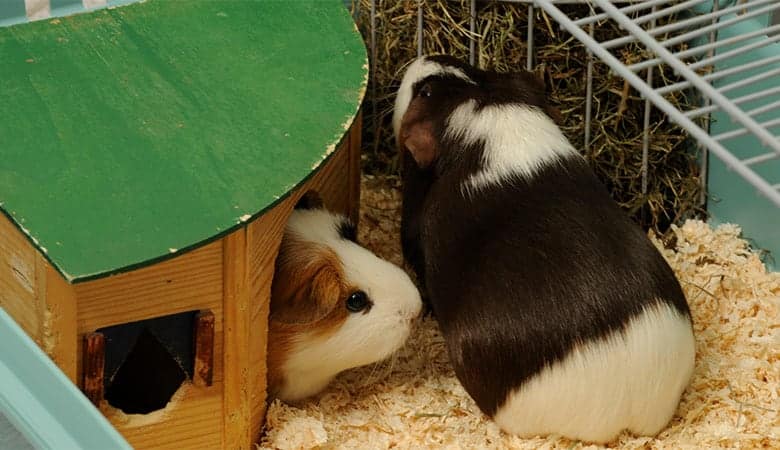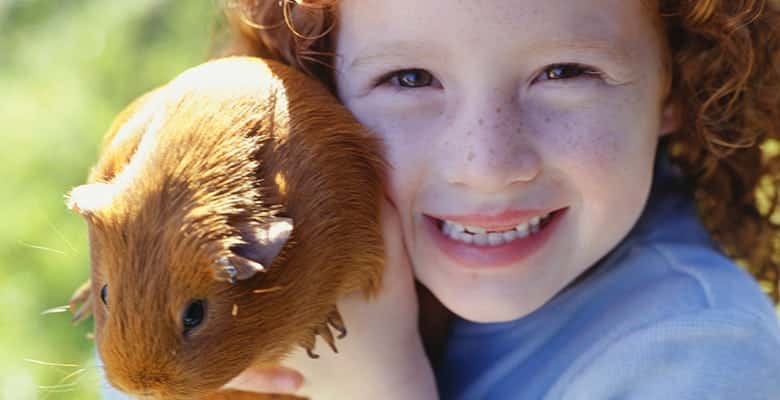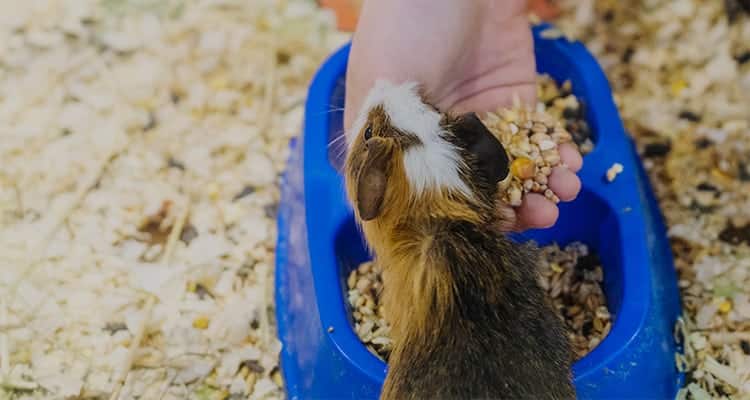Guinea pigs are great pets; however, most cages marketed for them are often too small, leaving them no space to roam. Having a cage that’s big enough allows your furry pet to have enough nesting space, a designated bathroom, and space to roam.
How large should a guinea pig cage be?
For one guinea pig, you need a 7.5 sq ft cage that’s 30 by 36 inches. Two guinea pigs will need 10.5 sqft in a 30 by 50-inch cage. Three pigs will need about 13sqft in a 30 by 62-inch cage and so on.
Most cages often utilize vertical space to increase the living area a pet has. While this may work for other pets, guinea pigs rely on floor space since they do a lot of digging, climbing, and burrowing during the day.
Read on to learn more about the importance of having the correct guinea pig cage size.
Why Size is Important
Compared to other rodent-like pets, guinea pigs are quite large, and despite this increase in size, the cages marketed for them are barely roomier than hamster or gerbil cages. Most cages often utilize vertical space to increase the living area a pet has.
While this may work for other pets, guinea pigs rely on floor space since they do a lot of digging, climbing, and burrowing during the day.
While ramps and platforms can help provide some variety, they need room to roam and even some time outside the cage.
Guinea pigs can measure between 8 to 10 inches (20 to 25 cm) in length and weigh between 1.5 to 2.6 lb (0.7 – 1.2 kgs), with some getting to even 6.6 lb (3 kgs) when fully grown.
This means that they need a lot of room to roam, nest, feed, drink and go to the bathroom. When picking a cage, the biggest factor you have to consider is how many guinea pigs you want to keep in one cage. Here are a few guinea pig cage size guidelines.
For one guinea pig, you need a 7.5 sq ft cage that’s 30 by 36 inches. Two guinea pigs will need 10.5 sqft in a 30 by 50-inch cage. Three pigs will need about 13sqft in a 30 by 62-inch cage and so on.
As you get more guinea pigs, you will need more space, and as you can see, a cuboid shape is the best because the ample lengths and widths offer enough space to roam.
Because they are not known for their climbing abilities, height doesn’t matter a lot when considering cage sizes.
Guinea pigs are social creatures. In the wild, these creatures level in herds and are very community-oriented. Living in a herd allows them to comfort one another, watch out, and protect each other from predators and any threats they may face.
Guinea pigs can pick and choose their social network. As they reproduce, their population increases, and large groups split into sub-groups consisting of 4 males and 7 females.
These subgroups are then free to choose individual living and sleeping spaces.
Recreating such conditions at home is hard, and not having enough living space can negatively affect your pets. Here are some of the benefits of getting a larger cage for your beloved pet.
Benefits of getting your guinea pigs a large cage

How would living in a small apartment that your bed barely fits in and has one window make you feel? Undoubtedly you would hate living there. Life would be dreary, and you might even suffer from depression. That’s what living in a small cage is like for guinea pigs.
There’s no space to move or jump around and a total lack of stimulation.
● Larger cages are one of the ways you can enrich the life of your guinea pigs. Devoid of stimulation, guinea pigs can quickly become bored and depressed. Having a larger home can contribute to their happiness and lead to your pet living a long healthy life. Remember the small apartment, even if you left to go to work, everyday life would still be dreary because you lack enough space to move about.
● Similar to hamsters, mice, gerbils, or rats, guinea pigs don’t utilize vertical space that much. They are clumsy creatures, and while having a few ramps can provide variety to the cage, floor space is the only thing that counts for them. Despite their size, exercise is still important as it can prevent heart and breathing problems, bumblefoot, and other health issues. Since they are quite active in the morning and evening, having a big cage allows them to work out independently before getting some time outside the cage.
● With a bigger living space, you can get more guinea pigs. These animals are social creatures and tend to do well in a herd or group. If you were to put two guinea pigs in a small cage, squabbles over territory would ensue. Larger cages allow for more roaming paces, toys, food, and water dishes. Your pets are likely to fight if they feel that their resources are threatened.
● Larger cages are easier to maintain because there’s less build-up of waste. Even with the best bedding material, it will start having an odor more quickly in a small cage. Guinea pigs are not known to be as enthusiastic about potty training as rabbits and thus tend to poop and pee close to where they eat and drink. Having a larger cage means you can easily dump the bedding often, thus reducing the clean-up you have to do.
● With larger enclosures, guinea pigs are free to be themselves and express a wide range of behaviors. This makes it easier to get to know them and their personalities, for instance, who loves playing and who is more relaxed.
What Size Hutch Do You Need for Two Guinea Pigs?
If you are caring for two guinea only, the size of the hutch matters greatly. We suggest a minimum of
7.5 square feet. 10.5 square feet measuring at 30” x 50” is better because you may not need a new hutch if you ever happen to get a third.
A 13 square feet which is 30” x 62 is what we have for our three guinea pigs. A pet shop that doesn’t have the required or suggested sizes may tell you that they are fine in smaller hutches together.
Do not agree with them and look online or elsewhere. 2 guinea pigs would benefit from a cage or hutch that is 5-6 feet in length.
Can a Guinea Pig Enclosure Be Too Big?
It would be a huge luxury for a guinea pig family to get their own room that is intended only for them with all their favorite toys and hay thrown around everywhere.
This is impossible for most of us and we have to be smart with how much space we can offer them while not sacrificing too much space in the living room which leaves us cramped or unable to move around freely.
No amount of space is too big for a guinea pig. They love to explore and will enjoy the larger space if you fill it with hiding spaces and activities. You can have a playpen in there too with ramps or obstacles.
Some guinea pigs will not appreciate all this space and may resort to claiming one section of it only to spend the majority of their time. If you see your guinea pigs not exploring the entire area, you can reduce the size of the space.

Other considerations to make when choosing a guinea pig cage
Aside from having enough room, there are other considerations you should make when creating a home for your guinea pig.
Location
After selecting an appropriately sized cage, you need to determine the best place to put it. This means thinking about things such as the temperature of the room. Ideal temperatures range between 65 to 75 degrees Fahrenheit, so somewhere cool will do.
You should also keep your guinea pig enclosures away from strong heat sources such as boilers, heating vents, wooden stoves, or direct sunlight. These furry little creatures cannot sweat, so they have no way of cooling down when they get too warm, meaning they can easily die from heatstroke.
However, you also don’t want to put your pet in an unheated room, garage, or breezy location. Even though they don’t like heat, cold and chilly places are just as bad.
Look for a draft-free area that’s away from doors and windows, preferably on an elevated surface. Also, keep them away from humid areas. The dampness promotes mold growth in their food and bedding, making them prone to getting sick.
Activity level

Guinea pigs are very social mammals and enjoy being close to family activity areas. They benefit a lot from the attention they see and hear. Consider placing them in a family or living room, but ensure they have a place to retreat to in case they want some quiet.
Despite being social, guinea pigs can sometimes be shy. Having tunnels, houses, and caves can make excellent places for them to retreat to. Along with sensitive noses, these furry little creatures have very sensitive hearing, so try and keep them away from stereos, TVs, and other noisy areas.
Bedding
Paper and straw make the best bedding material for guinea pigs. It is soft and odorless, meaning it can harm their little paws and sensitive senses.
Materials such as cedar or pine shaving are not ideal because when soiled, the aromatic wood shaving produce fumes that irritate your pet’s respiratory system. Ensure that the bedding is about 2 to 3 inches thick to help your guinea pig stay warm and allow it to burrow.
Food and water

Guinea pigs love eating with their front feet at the rim of the food bowl. Ensure you get a wide shallow bowl, preferably made from a material they can’t chew on, such as ceramic.
As for water, a sipper bottle is a better option than a water dish. They don’t use up a lot of floor space and are a lot more hygiene given how guinea pigs like to eat and drink. With the bottle, there are few chances of the water getting contaminated.
Toys
Just like kids, guinea pigs need things to play with. Simple wooden blocks or cardboard boxes are simple, cheap toy options. Since these little rodents love to gnaw at things, wood and cardboard make great toys. The gnawing also helps wear down their ever-growing teeth. For instance, you can make tunnels, caves, or little houses from cardboard giving your pets extra toys to play with.
For guinea pigs, the bigger the floor space, the better; for them, a big living area is not a luxury by a necessity that offers them room to play and live peacefully. Having a bigger cage can make a huge difference in the life of a guinea pig. It’s a simple way to get to know them as well as ensure they are happy and healthy.

